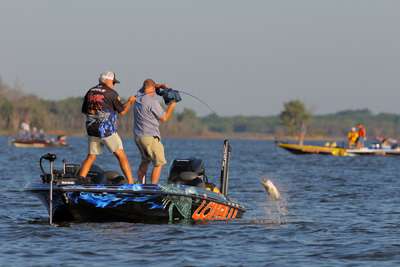
Despite the scorching summertime heat and blazing sunshine, Tommy Biffle can still fish in his comfort zone on a variety of fisheries throughout the country.
The flipping/pitching specialist prefers keeping his lure in shallow water, which he can still accomplish with excellent results if he can find shade, current or wave action. "It depends on the body of water you are on and what the conditions are to determine which one of them are going to be a key factor," says Biffle.
In the ideal scenario, Biffle would be flipping willow trees, which offer both cover and plenty of shade to keep bass shallow even when the summer heat soars into triple-digit temperatures. If a lake level remains high throughout the summer, Biffle also targets flooded buckbushes to catch shallow bass. However, if the lake is at normal level or low, Biffle can still catch shallow bass flipping to logs, laydown trees and stumps.
Bass tend to stay shallow more often on reservoirs with dingy water, but Biffle can key on shallow bass in "drinking-water-clear" lakes containing shoreline cover that provides shade. He recalls catching bass as shallow as 6 inches to 1 foot in the clear waters of Oneida Lake during his eighth-place finish in the 2009 Bassmaster Elite Series event.
His fish were holding in the shaded areas under overhanging trees, boat docks, dock walkways and in the weed line edges. Current in a river or creek always keeps bass shallower in the summertime because the flowing water stays cooler and generates oxygen. Wave action from wind and recreational boat traffic can also draw bass to the shallows in the heat of summer.
"The fish get up there because the wave action makes oxygen," Biffle says. "So the oxygen level is usually better up there real shallow than it is 3 or 5 feet deep." Soft plastics and jigs produce best for Biffle whenever he targets shallow summertime bass.
A Texas rigged Gene Larew Lures Biffle Bug is his choice for working through shallow cover. "If they are biting well enough, you won't have to work it," says Biffle. However, if the fish continue to ignore his lure on the initial fall, he inserts a rattle into the Bug's body. "It holds a rattle well since it is hollow on the inside and that also makes the rattle louder inside that chamber," Biffle says.
The Oklahoma pro also favors the kicking action of the Biffle Bug's legs for swimming the lure up and down through the limbs of a shallow laydown. His favorite Texas rig for flipping to shallow summer bass consists of the Biffle Bug in smoke/silver or black neon with a 4/0 hook and a 5/16-ounce sinker. "The 5/16 has always been about the right size weight for penetrating bushes or getting into any heavy cover," he says.
If Biffle encounters a strong water flow, he opts for a 3/8-ounce weight so the heavier sinker can drop the lure into the cover without being swept away by the current. When bass seem to prefer a slow, subtle presentation, Biffle selects a jig and plastic trailer combo which he lets fall to the bottom and slowly lifts through the cover.
"If I am fishing logs, stumps or docks I use a 3/8-ounce jig, but if I'm flipping it into some thick brush or heavy cover, I use a 1/2," says Biffle, who usually tips his jig with a Zoom Super Chunk Junior.
The five-time B.A.S.S. winner increases his chances of catching a kicker fish from the shallows by trailing his jig with a Biffle Bug. "It makes a big bait so you really need some big fish around to eat it," he advises.
His favorite jig-and-trailer color combinations are black/blue jig with blue sapphire trailer or a black/yellow jig with black neon or black soft plastic.
Originally published July 2011





